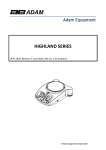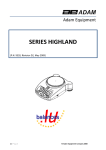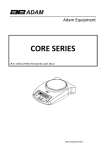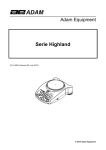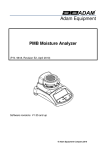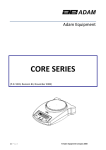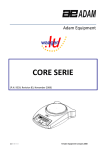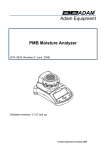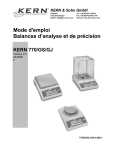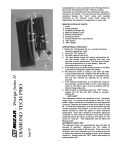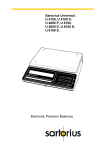Download Adam Equipment J1002 User's Manual
Transcript
Adam Equipment HCB J Precious Metals and Density Balance (P.N. 308660002 Revision D1, June 2013) Software 4.2 and above © Adam Equipment Company 2013 © Adam Equipment Company 2013 CONTENTS 1.0 INTRODUCTION .......................................................................................................2 2.0 SET UP ......................................................................................................................2 2.1 HCB J123, SETTING UP YOUR BALANCE .........................................................2 2.2 HCB J302, J1002 and J2002 SETTING UP YOUR BALANCE ............................6 2.3 PREPARING FOR USE........................................................................................10 2.4 KEYPAD / DISPLAY FUNCTION..........................................................................12 2.5 REAR PANEL .......................................................................................................13 2.6 INTERNAL RECHARGEABLE BATTERY ............................................................13 3.0 LOCATING AND PROTECTING YOUR BALANCE.................................................14 4.0 BASIC OPERATION ................................................................................................15 4.1 TURNING ON THE BALANCE .............................................................................15 4.2 ZEROING / TARE.................................................................................................15 4.3 WEIGHING ...........................................................................................................15 4.4 WEIGHING UNITS ...............................................................................................15 5.0 DENSITY FUNCTION..............................................................................................16 5.1 WEIGHING A SAMPLE ........................................................................................16 5.2 DISPLAY DENSITY ..............................................................................................17 6.0 DENSITY PARAMETERS........................................................................................19 6.1 SELECTING THE ALLOY TO TEST.....................................................................19 6.2 TEST OPTIONS ...................................................................................................19 6.3 LIQUID AND TEMPERATURE PARAMETERS...................................................19 6.4 ALLOY PARAMETERS ........................................................................................20 7.0 PARAMETERS ........................................................................................................23 7.1 ENABLING WEIGHING UNITS, F1 Unt.................................................................24 7.2 HOLD FUNCTION, F2 Hld .....................................................................................26 7.3 BACKLIGHT, F3 bL................................................................................................27 7.4 PRINTING PARAMETERS, F4 Ser .......................................................................27 7.5 AUTO POWER OFF, F5 OFF..................................................................................29 7.6 INTERNAL OR EXTERNAL CALIBRATION, F6 ICE ..............................................29 7.7 ADJUST THE VALUE OF THE INTERNAL MASS, F7 CA ......................................30 7.8 USER TECHNICAL PARAMETERS, F8 SEt ..........................................................31 8.0 USER CALIBRATION ..............................................................................................32 9.0 SERIAL INTERFACE SPECIFICATIONS ................................................................34 10.0 REMOTE DISPLAY ..............................................................................................36 11.0 TEMPERATURE SENSOR ..................................................................................36 12.0 TROUBLE SHOOTING.........................................................................................37 12.1 ERROR MESSAGES ........................................................................................37 12.2 REPLACEMENT PARTS AND ACCESSORIES ...............................................38 13.0 SPECIFICATIONS................................................................................................39 13.1 TECHNICAL SPECIFICATIONS .......................................................................39 13.2 COMMON SPECIFICATIONS...........................................................................39 14.0 WARRANTY INFORMATION ...............................................................................40 1 © Adam Equipment Company 2013 1.0 INTRODUCTION Thank you for purchasing your new HCB J Precious Metals and Density Balance. As with our popular HighlandTM series of balances the HCB J has all the features you really need: DC adapter with internal rechargeable battery, HandiCalTM calibration, backlit display, and ShockProtectTM with overload indicator. With the RS-232 interface for communication with printers and computers, splash-proof keypad, and sturdy plastic construction, the HCB J will be a balance you can rely upon. We hope that you enjoy using your new balance. 2.0 SET UP 2.1 HCB J123, SETTING UP YOUR BALANCE 1) Remove the balance and all accessories from the packaging 2 © Adam Equipment Company 2013 2) Remove the shipping protection screw and transit disc from the top of the balance 3) Place the Beaker Support assembly onto the top housing with the Temperature Sensor cable running down the back of the balance. 4) Lift the beaker away to the rear and locate the Density Chamber support into the receptacle with the arrow facing the rear of the balance. Press gently to insert it then secure the support in the center using the M4 x 20mm screw which is packed in the accessory bag. Tighten only enough to secure the pan support so that it does not rock in the receptacle. 3 © Adam Equipment Company 2013 5) Replace the beaker onto the beaker support and pull the Temperature Sensor cable through the clip to take up any slack or loose amount of cable. 6) Place the Density Chamber over the beaker with the handle of the lid at the front and allowing for the sample pan to hang freely inside it. Secure the Chamber to the support by rotating it gently clockwise and locking into the 3 tabs. Take care not to push down or use excessive force on the Chamber when fixing as damage can be caused. 4 © Adam Equipment Company 2013 7) Plug the Temperature sensor into the 5 pin connector, and the remote Indicator into the 6 pin connector at the rear of the balance. 8) Make sure again that the cable from the Temperature Sensor is tightly pulled down through the clip and that it does not interfere or sit close to the Density Chamber or Chamber support. If the cable is touching against any of these parts it will result in incorrect weighing and karat calculations. Position the balance and Remote Indicator in a convenient place and adjust the feet to show a level state. Switch on the balance whilst using battery power or connect the adaptor to the mains supply. 5 © Adam Equipment Company 2013 2.2 HCB J302, J1002 AND J2002 SETTING UP YOUR BALANCE 1) Remove the balance and all accessories from the packaging 2) The following items are included: HCB J balance body Power Supply Weighing Chamber Assembly that includes Sample Pan with suspension wires Chamber Cover Chamber Support Liquid Beaker Temperature Sensor Temperature Sensor Clip Remote Display 1ea M3 x 20 hex screw for Chamber Support Mounting 6 © Adam Equipment Company 2013 7 © Adam Equipment Company 2013 3) Remove the shipping protection screw and transit disc from the top of the balance. 4) Place the Chamber Support assembly onto the top housing. Press gently to insert it then secure the support in the center using the M4 x 20mm screw which is packed in the accessory bag. Tighten only enough to secure the pan support so that it does not rock in the receptacle. 8 © Adam Equipment Company 2013 5) Place the liquid chamber onto the support. Ensure the line marking the water level is to the front. 6) Place the temperature sensor onto the rear panel of the chamber. Pull the Temperature Sensor cable through the clip to take up any slack or loose amount of cable. 9 © Adam Equipment Company 2013 7) Position the sample pan in the beaker area and connect the 4 suspension wires to the rings in the support frame. 8) Plug the Temperature sensor into the 5 pin connector, and the remote Indicator into the 6 pin connector at the rear of the balance. 9) Make sure again that the cable from the Temperature Sensor is tightly pulled down through the clip and that it does not interfere or sit close to the Density Chamber or Chamber support. If the cable is touching against any of these parts it will result in incorrect weighing and karat calculations. 2.3 PREPARING FOR USE Position the balance and Remote Indicator in a convenient place and adjust the feet to show a level state. Switch on the balance whilst using battery power or connect the adaptor to the mains supply. 10 © Adam Equipment Company 2013 When you are preparing to do a Density Test it will be necessary to fill the chamber with liquid. The choice of the type of liquid will be left for the user to decide, however some solvents may not be compatible with the Polycarbonate of the chamber or ABS of the Sample Pan. Test a small sample of the liquid on the plastics before filling the beaker if unsure. Fill the chamber with liquid lift the Chamber lid, or remove the Density Chamber from its support and pour through a funneled container. The beaker should be filled no higher than the maximum filling mark and needs to cover the metal part of the Temperature Sensor cable. If the Chamber is removed refit the Chamber once finished as described earlier. Care should be taken to not spill any liquid onto or inside the balance as damage may occur which is not covered under the normal warranty terms. To fill the chamber whilst it is away from the balance it will be necessary to remove the Temperature Sensor and clip from the chamber which then allows it to be removed from the support. The cable will need to be pulled gently upwards from below the Temperature Sensor clip to allow easy removal of the clip. When re-fitting the Temperature Sensor and clip follow the previous instructions ensuring the cable is pulled down into a tight position and lifted away from the Chamber. If water is used a few drops of liquid detergent may be added to the water to improve the wetting ability and avoid trapped bubbles of air on the sample being tested. Stir well to distribute the soap evenly. When removing samples from the chamber use a towel to dry the samples so the water does not splash onto the balance. 11 © Adam Equipment Company 2013 2.4 KEYPAD / DISPLAY FUNCTION The keypad and display have a number of features as shown and explained below: KEYS PRIMARY FUNCTION To turn the balance On or Off. SECONDARY FUNCTION ---- [On/Off] [Tare] Tares the balance and shows the net weight value. Pressing the [Tare] again will reset another tare value [Hold/Print] Will set the current weight to be held on the display and will also send the current weight data to the RS232 interface. When displaying the results of the density test pressing [Hold/Print] will send the results to the interface. [Unit/Clr] Pressing this key will cycle through the weighing units which are enabled [Density] [Air/Liquid] A secondary function of "Enter" is for setting parameters or other functions. When setting some parameters this key will move the flashing digit to the right. When in density mode pressing the [Unit/Clr] will return the display to normal weighing mode. Pressing after the weights in the air Whilst setting parameters it will show and in the liquid have been stored will the previous option, or decrease the show the density and karat results. value of the flashing digit. Stores the current weight into the Whilst setting parameters it will show memory for density determination. the next option, or increase the value of the flashing digit. Low battery indicator Weight in Air Hold symbol Alpha numeric display Weight in Liquid Zero Stable Capacity tracker Weighing digits 12 © Adam Equipment Company 2013 2.5 REAR PANEL The rear panel has connectors for the power, RS232, remote display and temperature sensor. For connections to these see the relevant sections. 2.6 INTERNAL RECHARGEABLE BATTERY The balance can be operated from the internal rechargeable battery or using an adapter. The battery life is approximately 24 hours with the backlight off. Depending on the usage of the backlight the lifetime of the battery will reduce and using the remote display will lessen the battery life considerably. The display will show an indication when the battery needs to be charged. To charge the battery plug the adapter into the POWER socket at the back of the balance and connect it to the mains power supply. The charging indicator at the left top corner of the LCD will be on to show it is charging and will turn green when the battery is fully charged. 13 © Adam Equipment Company 2013 3.0 LOCATING AND PROTECTING YOUR BALANCE In order to keep your balance functioning at its best we suggest that you do the following: Avoid extremes of temperature. Do not place in direct sunlight or near air conditioning vents. Make sure the balance is located on a strong table and free from vibration. Avoid unstable power sources. Do not use near large users of electricity such as welding equipment or large motors. Do not let the balance battery go flat. If you are not using it for a long time you should charge the battery periodically to make sure the battery does not lose its charge. Keep free from vibration. Do not place near heavy or vibrating machinery. Avoid high humidity that might cause condensation. Keep away from direct contact with water. Do not spray or immerse the balance in water. Do not place near open windows, air-conditioning vents or fans that may cause a draft and unstable readings. Keep the balance clean. Do not stack material on the balance / balance pan when it is not in use. 14 © Adam Equipment Company 2013 4.0 BASIC OPERATION 4.1 TURNING ON THE BALANCE Plug in the unit using the adapter or use the internal rechargeable battery. It is recommended that you charge the battery for at least 8 hours before first use. 1) To turn on press the [On/Off] key once and release. The balance will show the software revision and the battery voltage then self-test before showing the current temperature as measured or defined by the user. The balance will show the stable sign and zero weight on the display and is now ready to use. 2) To turn the balance off after use press the [On/Off] key again. There is an auto power-off function that will automatically turn the unit off if not used for a period of time; this can be set in the parameters section. 4.2 ZEROING / TARE You can press the [Tare] key to set a new zero point and show a zero reading. This may be necessary if the weight reading is not indicating zero with nothing on the pan. The zero indicator will show up in the upper left corner of the LCD. If you are using a container whilst weighing then you can place this on the weighing pan and press the [Tare] key. Providing the container weight is more than 4% of the maximum capacity of the balance the display will show a zero reading and NET will light up on the display. You can then weigh your sample in the container. Taring a container will reduce the maximum weighing capacity available of the balance. 4.3 WEIGHING To determine the weight of a sample place the sample in the container. The display will show the weight of the sample and the unit of weight currently in use. The stable indicator will light up when the reading is stable. 4.4 WEIGHING UNITS To change the weighing units press [Unit/Clr] which will cycle through the options of units that are enabled. See Parameters 7.1 Enabling Weighing Units to enable or disable the weighing units. 15 © Adam Equipment Company 2013 5.0 DENSITY FUNCTION Once the HCB J is prepared for a density test and the parameters have been set for doing the Density Determination (see section 6) the following procedure is used to weigh the sample in air, and then again in water or another liquid, allowing you to determine the density of the sample and if applicable a determination of the purity (karat) of the gold in the sample. The Hold function must be enabled (see section 7.2) for the Density function to operate correctly. The Density parameters (see Section 6.0) should be checked before doing a test as the results are dependent on the liquid and alloy settings. NOTE: To perform a density only test set the parameters for density test (Section 6) to Silver (Ag), Set Hold to Automatic (Hd Au), Select water for the liquid (H2O) and automatic temperature detection (Auto tmP). Then when doing the density test only the density of the sample will be displayed. 5.1 WEIGHING A SAMPLE Place the sample to be weighed in air on top of the lid of the Density Chamber and allow the weight displayed to become stable. If the Hold function is set to manual press the [Hold/Print] key. The capacity tracker at the bottom of the display will move from right to left and when ready the display will show “HOLD”. If the Hold function is set to automatic you are not required to press the [Hold/Print] key once the weighing in air becomes stable. After the Hold symbol is shown press the [Air/Liquid] key to store this value. Wait for the Weight in Air indicator to be displayed before you proceed to the next step. Remove the sample and ensure the balance returns to zero. If necessary press the [Tare] key to zero the display. Open the lid of the Density Chamber and carefully place the sample in the liquid on the suspended pan. It may be helpful to shake the sample gently to dislodge any air bubbles. Close the lid of the Density chamber and allow the weight displayed to become stable. If the Hold function is set to manual press the [Hold/Print] key. The capacity tracker at the bottom of the display will move from right to left and when ready the 16 © Adam Equipment Company 2013 display will show “HOLD”. If the Hold function is set to automatic you are not required to press the [Hold/Print] key once the weighing in liquid becomes stable. After the Hold symbol is shown press the [Air/Liquid] key to store this value. The Weight in Liquid indicator will be shown at which point the sample can be removed. If when weighing in air the weighing unit starts to flash a message of “ADD”, this informs you that the weight of the sample may not be enough to give accurate calculations and therefore it is recommended that a larger sample weight is used. At this point the USER can add more weight to the lid until the flashing stops which signifies that the minimum sample weight required has been met. Once the flashing stops remove the sample from the lid of the chamber, press the [Unit/Clr] key and make sure the display shows zero, place the sample back onto the lid to start the process again. Minimum sample weights are as follows: HCB J123 – 2g HCB J302 – 2g HCB J1002 – 5g HCB J2002 – 10g * Please note that if extra weight is not added to meet the minimum sample weight requirements when the message “ADD” is being displayed, the balance will continue to calculate based on the sample weight at that time. 5.2 DISPLAY DENSITY Press the [Density] key to display the density of the sample, ie- “14.2 den” Press the [Density] key a second time to display the Karat value for the sample. For example if gold with silver is selected the display would show “ 14 KAg”. Like wise for other display options the display might show “ 14 KCu” for gold with copper, “ 14 K11” for gold with silver and copper in a 1:1 ratio, “ 14 KMn” for a ratio other than 1:1 and “ 14 K o” for other density of alloys that might be used. See section 6.2 for details of setting the alloy options. Press the [Density] key a third time to display the content of gold determined during the test, ie- “583 Cnt”. If the density value is outside of the expected range (see 17 © Adam Equipment Company 2013 table below), the karat value and content value will not be displayed. An error message will be shown. Only the density value will be available. To return to normal weighing press the [Unit/Clr] key. To run another test ensure all weight is removed from the pan support in the water and from the Density Chamber. Gold Density values used for Karat determination for silver and copper alloys. GOLD KARAT Typical CONTENT SILVER(Ag) COPPER(Cu) Ag:Cu=1:1 7K 8K 9K 10K 11K 12K 13K 14K 15K 16K 17K 18K 19K 20K 21K 22K 23K 24K 292/1000 333/1000 375/1000 417/1000 458/1000 500/1000 542/1000 584/1000 625/1000 667/1000 708/1000 750/1000 792/1000 834/1000 875/1000 917/1000 958/1000 1000/1000 12.14(12.01-12.27) 12.42(12.28-12.55) 12.70(12.56-12.84) 13.00(12.85-13.14) 13.31(13.15-13.46) 13.64(13.47-13.80) 13.98(13.81-14.15) 14.34(14.16-14.52) 14.72(14.53-14.91) 15.12(14.92-15.32) 15.54(15.33-15.75) 15.99(15.76-16.21) 16.46(16.22-16.70) 16.97(16.71-17.22) 17.50(17.23-17.77) 18.07(17.78-18.36) 18.68(18.37-19.16) 19.32(19.17-19.48) 10.60(10.46-10.73) 10.89(10.74-11.03) 11.19(11.04-11.34) 11.51(11.35-11.67) 11.85(11.68-12.02) 12.22(12.04-12.40) 12.61(12.41-12.80) 13.02(12.81-13.22) 13.46(13.23-13.68) 13.93(13.69-14.16) 14.43(14.17-14.69) 14.98(14.70-15.25) 15.56(15.26-15.86) 16.19(15.87-16.51) 16.88(16.52-17.23) 17.63(17.24-18.01) 18.44(18.02-19.09) 19.32(19.10-19.54) 11.32(11.18-11.45) 11.60(11.46-11.74) 11.90(11.75-12.04) 12.21(12.05-12.36) 12.54(12.37-12.70) 12.89(12.71-13.06) 13.26(13.07-13.44) 13.65(13.45-13.84) 14.06(13.85-14.27) 14.50(14.28-14.72) 14.97(14.73-15.20) 15.47(15.21-15.72) 16.00(15.73-16.27) 16.57(16.28-16.86) 17.18(16.87-17.49) 17.84(17.50-18.18) 18.55(18.19-19.12) 19.32(19.13-19.51) Platinum Density Values used for determination of Platinum purity Pt Content Nickel(Ni) Palladium(Pa) Ni:Pa=1:1 1000 1000/1000(975-1025) 950 950/1000(925-975) 20.04(19.40-20.72) 20.64(20.26-21.04) 20.34(19.82-20.88) 900 900/1000(875-925) 18.8(18.24-19.40) 19.88(19.54-20.26) 19.33(18.87-19.82) 850 850/1000(825-875) 17.71(17.21-18.24) 19.18(18.86-19.54) 18.42(18.00-18.87) 800 800/1000(775-825) 16.73(16.29-17.21) 18.53(18.24-18.86) 17.6(17.21-18.00) 750 750/1000(725-775) 15.86(15.46-16.29) 17.92(17.65-18.24) 16.84(16.48-17.21) 700 700/1000(675-725) 15.08(14.71-15.46) 17.37(17.10-17.65) 16.14(15.82-16.48) 650 650/1000(625-675) 14.37(14.03-14.71) 16.83(16.58-17.10) 15.5(15.20-15.82) 600 600/1000(575-625) 13.72(13.42-14.03) 16.33(16.09-16.58) 14.91(14.63-15.20) 550 550/1000(525-5750 13.13(12.85-13.42) 15.86(15.63-16.09) 14.37(14.11-14.63) 500 500/1000(475-525) 12.58(12.33-12.85) 15.41(15.20-15.63) 13.86(13.62-14.11) 18 © Adam Equipment Company 2013 6.0 DENSITY PARAMETERS To use the density function it is necessary to set parameters describing the liquid used and the alloy being tested. These parameters can be set when the balance is in the normal weighing mode. 6.1 SELECTING THE ALLOY TO TEST The HCB J allows the alloy to be tested to be selected by the user. Select either Gold (Au), Platinum (Pt), Silver (Ag) or disable the alloy selection and show the weight only. When displaying the weight press the [Air/Liquid] key to select the alloy to be tested. The display will show the last alloy selected i.e. “ ON Au” Select a new alloy by pressing the [Air/Liquid] or [Density] key to show “On Au” for gold, “ON Pt” for Platinum, “ON Ag” for silver or “ON WEI” to display the weight only. Press the [Unit/CLR] key to return to weighing with the alloy selected active. 6.2 TEST OPTIONS During normal weighing with the display showing zero weight, press the [Density] key. If the display does not change to show Liquid check the parameter for the Hold Function (section 7.2). If it has been set to off “Hd Off”, density is disabled and this section will not operate. Set to Hold On, “Hd On”, or Hold Automatic, “Hd AU”, to enable the density function. The display will show Liquid to identify the section for setting parameters associated with the liquid used. Press [Tare] to enter this section or press [Air/Liquid] to view the Alloy parameters. When Alloy is displayed press [Tare] to enter this section or press [Air/Liquid] to return to the Liquid parameters. 6.3 LIQUID AND TEMPERATURE PARAMETERS The parameters available are water (H2O) and any other user definable liquid. If water is used and selected the next parameter will ask to determine the 19 © Adam Equipment Company 2013 temperature of the water, selections are either using the automatic temperature sensor or to manually input the temperature. If another liquid is used then the user must set the density of that liquid. The display will show Liquid, Press [Tare] to enter this section. Press [Air/Liquid] or [Density] to select H2O or Define den. Press [Tare] to select the setting or press [Unit/Clr] to return to the Liquid display. If H2O is selected the display will show the current setting for the temperature determination, either Auto tmp, or Set tmp. Press [Air/Liquid] or [Density] to select the option, then press [Tare] to store the selection. If Auto tmp is selected the display will show the current temperature measured by the external temperature probe. Press [Tare] to accept the value and return to Liquid. If Set tmp was selected the display will show the temperature last set by the user i.e. 24 °C tmp . To change the current setting press the [Air/Liquid] or [Density] key to increase or decrease the value. Press [Tare] when the correct value is shown. The display will return to show Liquid. Press [Unit/Clr] to return to weighing or press [air/Liquid] or [Density] to change the display to set the Alloy parameters. If Define den was selected for setting the density of another liquid press [Tare] and the display will show the current valued stored. Enter the value for the density of the liquid you are using (in g/cc3) by using the [air/Liquid] or [Density] keys to change the value of the flashing digit on the display, and the [Hold/Print] key to change the flashing digit position. Press [Tare] when the correct value is shown. The display will return to show Liquid. Press [Unit/Clr] to return to weighing or press [air/Liquid] or [Density] to change the display to set the Alloy parameters. 6.4 ALLOY PARAMETERS If Gold (Au) has been selected for the alloy to test the balance will compute the density based on the weight values recorded. The value for purity (karats) and content will be computed depending on the alloy selected by the user. The alloy 20 © Adam Equipment Company 2013 options are Silver (Ag), Copper (Cu), Silver: Copper in a 1:1 ratio (AG:CU 1-1), Silver: Copper in a user settable ratio (Ag:Cu: M-N) or a user defined density (Define den). When the display shows Alloy, press the [Tare] key to enter this section. The display will show the current setting for the alloy as above. Press the [air/Liquid] or [Density] key to change the display to another setting, then press [Tare] to select the setting. When the sample is gold mixed with an alloy the user needs to select the option that describes the alloy used. If the alloy is Silver (Ag), Copper (Cu) or Silver plus Copper in a 1:1 ratio (AG:CU 1-1) select the option shown and press [Tare] to store the selection. The display will return to show Alloy. Press [Unit/Clr] to return to weighing or select the Liquid setting as above. If the alloys are in another known ratio of Silver to Copper (Ag:Cu: M-N), or the alloy is another metal of known density (Define den) then following pressing [Tare] the display will show the current value stored for each option. To set the ratio or density use the [Air/Liquid] or [Density] keys to change the flashing digit, and the [Hold/Print] key to move the flashing digit to the right. Once the value is set, press the [Tare] key to store the value. The display will return to show Alloy. Press [Unit/Clr] to return to weighing whereupon you are now ready to proceed as section 5 to perform density testing. If Platinum (Pt) has been selected for the alloy to test the balance will compute the density based on the weight values recorded. The value for purity (karats) and content will be computed depending on the alloy selected by the user. The alloy options are Nickel (NI), Palladium (PA), Nickel:Palladium in a 1:1 ratio (Ni:PA 1-1), Nickel:Palladium in a user settable ratio (Ni:PA M-N) or a user defined density (Define den). When the display shows Alloy, press the [Tare] key to enter this section. The display will show the current setting for the alloy as above. Press the [Air/Liquid] or [Density] key to change the display to another setting, then press [Tare] to select the setting. 21 © Adam Equipment Company 2013 When the sample is Platinum mixed with an alloy the user needs to select the option that describes the alloy used. If the alloy is Nickel (Ni), Palladium (PA) or Nickel plus Palladium in a 1:1 ratio (Ni:PA 1-1) select the option shown and press [Tare] to store the selection. The display will return to show Alloy. Press [Unit/Clr] to return to weighing or select the Liquid setting as above. If the alloys are in another known ratio of Nickel plus Palladium (Ni:PA M-N), or the alloy is another metal of known density (Define den) then following pressing [Tare] the display will show the current value stored for each option. To set the ratio or density use the [Air/Liquid] or [Density] keys to change the flashing digit, and the [Hold/Print] key to move the flashing digit to the right. Once the value is set, press the [Tare] key to store the value. The display will return to show Alloy. Press [Unit/Clr] to return to weighing whereupon you are now ready to proceed as section 5 to perform density testing. If Silver (Ag) has been selected for the alloy to test the balance will compute the density based on the weight values recorded. There are no options for setting the composition of the silver, only the density will be shown. 22 © Adam Equipment Company 2013 7.0 PARAMETERS The balance has 8 parameters that can be set by the user. FUNCTION F1 Unt SECTION See section 7.1 F2 HLd See section 7.2 F3 bL See section 7.3 DESCRIPTION Sets the units to be used g, ct, GN, dwt, oZt, Oz, Lb, MM, t, tLH, tLS, tLT, tLJ Sets the operation of the Hold function On HD: Manual hold the weight whit the [Hold/Print] key Auto HD: Weight held automatically when stable OFF HD: Hold function Off, Density function disabled Sets the backlight on BL: backlight always on AU BL: backlight automatically turns on when a weight is placed on the pan or a key is pressed oFF BL: backlight always off F4 SEr See section 7.4 Sets the print parameters F5 OFF See section 7.5 Sets the auto power-off parameter F6 ICE See section 7.6 Selects Internal or external calibration mode F7 CA See section 7.7 Calibration mass value fine adjustment F8 SEt See section 7.8 User Parameters for auto zero, filter and stability tECH Technical parameters setting mode / factory setting 23 © Adam Equipment Company 2013 7.1 ENABLING WEIGHING UNITS, F1 UNT You can enable and disable the weighing units available to the user when they press the [Unit/Clr] key as described in section 4.4 Weighing Units. 1) Switch on the balance then press and hold the [Unit/Clr] key during the selfchecking test of the display. 2) After a few seconds, the display will show the first function F1 Unt. 3) When F1 Unt is displayed you can press the [Unit/Clr] key to return to normal weighing or press [Air/Liquid] to go to the next function. 4) When F1 Unt is displayed you can press the [Tare] key to view the current setting for the weighing units. 5) Press [Unit/Clr] at any time to return to the parameter heading. 6) Pressing the [Hold/Print] key will cycle through the other units along with their current settings. For example, if oFF is displayed with the weighing unit Carats, the user will not be able to use this unit while weighing. 7) Pressing the [Air/Liquid] key will change the setting of a particular unit. For example, to enable the weighing unit Carats, change the setting to on by pressing the [Air/Liquid] key. 8) Note that grams will always be enabled. 24 © Adam Equipment Company 2013 The following table shows different units which are available to the user and the conversion factors for each. Name of the Description Units Grams A standard metric unit Carats Used for weighing jewelry and gems, etc. Grains A basic weighing unit in the imperial system. Used to weigh gun powder. Pennyweight Pennyweight was the weight of a silver penny in medieval England. Equals to 1/20th of an Ounce Troy. Ounce Troy Troy ounce- used for weighing gold, silver and in pharmacy. Ounce Avoirdupois ounce. 16 ounces make a pound. Pounds Standard weighing unit in UK/USA. Mommes A weighing unit used in Japan to weigh pearls. Tola An Asian weighing unit Taels Hk Hong Kong Taels Taels S Singapore Taels Taels T Taiwan Taels Taels J Japan Taels Conversion Factor 1.0 5.0 15.43236 Display Symbol g ct GN 0.6430149 dwt 0.03215075 oZt 0.035274 oZ 0.0022046 0.266667 Lb MM 0.085735 0.026717 0.026455 0.026667 0.026659 t tL H tL S tL T tL J After setting the units to on or off, press [Unit/Clr] or [Tare] to return to the function menu. 25 © Adam Equipment Company 2013 7.2 HOLD FUNCTION, F2 HLD The hold function may be set to automatic, manual or off by the user. If the hold function is disabled the density function will not work. If it is set to auto the balance will hold the weight display when it becomes stable. If it is set to manual the user must press the [Hold/Print] key to set the hold function. AU Hd Off Hd On Hd Sets the hold function to operate automatically when a weight is stable. Sets the hold function to off. The Density function will not operate. The [Hold/Print] key will function only as a print key. Sets the hold function to be on when the user presses the [Hold/Print] key. 1) Switch on the balance then press and hold the [Unit/Clr] key during the selfchecking test of the display. 2) After a few seconds, the display will show the first function F1 UNT. 3) Press the [Air/Liquid] key to select F2 Hld . 4) Press the [Tare] key to view the current setting for the hold function. 5) To change the setting press the [Air/Liquid] key to scroll through and select a new setting as shown above. 6) Press [Tare] to confirm and move to the next setting. 7) When F3 bL is displayed press the [Tare] key to enter the parameter, the [Unit/Clr] key to return to weighing, or press [Air/Liquid] to go to the next function. 26 © Adam Equipment Company 2013 7.3 BACKLIGHT, F3 bL The backlight may be enabled or disabled by the user. If the backlight is disabled the battery life will be greater. The following settings are available: AU bL On bL Off bL Sets the backlight to operate automatically when a weight is placed on the balance or a key is pressed. Sets the backlight to be on at all times. Sets the backlight to be off at all times. 1) Switch on the balance then press and hold the [Unit/Clr] key during the selfchecking test of the display. 2) After a few seconds, the display will show the first function F1 UNT. 3) Press the [Air/Liquid] key to select F3 bL . 3) Press the [Tare] key to view the current settings for the backlight. 4) To change the setting press the [Air/Liquid] key to scroll through and select a new setting as shown above. 5) Press [Tare] to confirm and move to the next setting. 6) When F4 Ser is displayed press the [Tare] key to enter the parameter, the [Unit/Clr] key to return to weighing, or press [Air/Liquid] to go to the next function. 7.4 PRINTING PARAMETERS, F4 Ser 1) Switch on the balance then press and hold the [Unit/Clr] key during the selfchecking test of the display. 2) After a few seconds, the display will show the first function F1 UNT. 3) Keep pressing the [Air/Liquid] key until F4 SEr is displayed. 4) Press the [Tare] key to view the current setting. 27 © Adam Equipment Company 2013 5) The following options are available for setting the serial output functions: Mode Print Feature Auto Mod After density is tested it will automatically send data for the test results to the printer as shown in section 9. Set Mod After density is tested and during the time the results are displayed press [Hold/Print] to send the data to the printer. This allows the user to print only when they are ready. Pressing [Hold/Print] a second time will send the data again. Press the [Air/Liquid] key to change the setting. Press [Tare] to confirm and move to the next setting. 6) Setting the baud rate. This is the transmission speed for communication with printers and computers. The selected rate must match that of the other device for communications to work. The following settings are available: 2400 bPS 4800 bPS 9600 bPS 7) Press the [Air/Liquid] key to change the setting. 7) Press [Tare] to confirm and move to the next setting. 8) When F5 oFF is displayed press the [Tare] key to enter the parameter, the [Unit/Clr] key to return to weighing, or press [Air/Liquid] to go to the next function. *Please see section 9 for more printing details 28 © Adam Equipment Company 2013 7.5 AUTO POWER OFF, F5 OFF OFF The auto power off function helps conserve power by automatically turning the balance off when it is not in use. The Auto power off time can be set by the user in minutes, or to not be in operation (OFF). 1) Switch on the balance then press and hold the [Unit/Clr] key during the selfchecking test of the display. 2) After a few seconds, the display will show the first function F1 UNT. 3) Keep pressing the [Air/Liquid] key until F5 OFF is displayed. 4) Press the [Tare] key to view the current setting. 5) Press [Air/Liquid] to change the setting to (Off, 5, 10, 20 or 30 minutes). 6) Press [Tare] to confirm and move to the next setting. 7) When F5 oFF is displayed press the [Tare] key to enter the parameter, the [Unit/Clr] key to return to weighing, or press [Air/Liquid] to go to the next function. 7.6 INTERNAL OR EXTERNAL CALIBRATION, F6 ICE You can select to use the internal mass or an external mass to calibrate the balance. 1) Switch on the balance then press and hold the [Unit/Clr] key during the selfchecking test of the display. 2) After a few seconds, the display will show the first function F1 UNT. 3) Keep pressing the [Air/Liquid] key until F6 ICE is displayed. 4) Press the [Tare] key to view the current setting. 5) To change the setting press the [Air/Liquid] key to select either Int (internal calibration) or Etl CAL (external calibration). CAL 6) Press [Tare] to confirm and move to the next setting. 7) When F7 CA is displayed press the [Tare] key to enter the parameter, the [Unit/Clr] key to return to weighing, or press [Air/Liquid] to go to the next function. 29 © Adam Equipment Company 2013 7.7 ADJUST THE VALUE OF THE INTERNAL MASS, F7 CA The internal mass value stored in memory can be adjusted if required. 1) Switch on the balance then press and hold the [Unit/Clr] key during the selfchecking test of the display. 2) After a few seconds, the display will show the first function F1 UNT. 3) Press the [Air/Liquid] key until F7 CA is displayed. 4) Press the [Tare] key to view the current setting. 5) The display will show the current value with the first digit flashing. To change the flashing digit position press the [Hold/Print] key. Press the [Air/Liquid] key to increase the value or the [Density] key to decrease the value. The internal calibration weight should only change between 95.00 and 105.00 grams or 495.00 and 505.00 grams (depending upon the model). 6) Press [Tare] to confirm and move to the next setting. 7) When F8 SEt is displayed press the [Tare] key to enter the parameter, the [Unit/Clr] key to return to weighing, or press [Air/Liquid] to go to the next function. *Changing the value of the internal mass will affect the weighing readings following an internal calibration. To check if your internal mass value is correct you should only use high quality weights that are accurate to the readability of the balance. 30 © Adam Equipment Company 2013 USER TECHNICAL PARAMETERS, F8 SEt 7.8 The balance has a number of technical parameters the user can adjust. Display Description Default Value Filter settings - 1 to 3 n FIL 1 FIL 1 will allow the display to update at it’s fastest The Automatic Re zero range - 1 to 7 n ZEO 4 ZEO 1 is the minimum A/Z range and 7 is the maximum Stability symbol range - 1 to 6 n STA 2 STA 1 is the smallest stability range and 6 is the largest. 1) Switch on the balance then press and hold the [Unit/Clr] key during the selfchecking test of the display. 2) After a few seconds, the display will show the first function F1 UNT. 3) Keep pressing the [Air/Liquid] key until F8 SET is displayed. 4) Press the [Tare] key to view the current setting. 5) To change the settings press the [Air/Liquid] key. Press the [Tare] key to store the setting and advance to the next parameter. When complete the display will show the TECH parameter. The display will now show TECH. This parameter is for qualified technicians only and requires entry via a pass code. Press the [Unit/Clr] key to return to weighing or press [Air/Liquid] to go to the first function again. 31 © Adam Equipment Company 2013 8.0 USER CALIBRATION The Highland series of balances comes standard with HandiCalTM internal calibration to make calibrating the balance quick and easy. However you can also calibrate the balance using an external verification weight if needed. The HandiCal method is the default but if you would like to use external calibration then you must first enable this via the parameter (section 7.6 Selecting the Internal or External Calibration). Install the handle for the calibration as shown below. To calibrate the balance the handle is pushed to the side which will lower the calibration mass. Internal Calibration using HandiCal 1) Press and hold the [Air/Liquid] and [Density] keys at the same time and power on the balance. 2) Release both keys when the display shows unload. 3) Remove any weight from the pan assembly and press the [Tare] key when the stable sign is shown. 4) The display will show C Int. Press the [Tare] key and the display will show LoAd. 5) Move the handle fully across as shown above which will lower the internal calibration mass onto the pan assembly inside the balance. Press the [Tare] key once the stable sign is shown. 6) The display will show PASS if the calibration is successful. Move the handle back to its original position and the display will show zero. 32 © Adam Equipment Company 2013 External Calibration 1) Press and hold the [Air/Liquid] and [Density] keys at the same time and power on the balance. 2) Release both keys when the display shows unload. 3) Remove any weight from the pan assembly and press the [Tare] key when the stable sign is shown. 4) The display will show an acceptable mass that can be used to calibrate the unit. You can change this value by pressing the [Air/Liquid] key to match the calibration mass you may have. 5) The calibration masses that can be used are as follows: Model # Weight 1 Weight 2 Weight 3 HCB J123 50g 70g 100g HCB J302 100g 200g 300g HCB J1002 500g 700g 1000g HCB J2002 500g 1000g 2000g 6) Once the calibration weight has been selected press the [Tare] key 7) The display shows LoAd. Place your weight on the pan. Press the [Tare] key after the stable sign is shown. 8) The display will show PASS if the calibration is successful. 9) Remove the weight and the display will show zero. NOTE: If the calibration fails try doing the calibration again. The calibration must agree with the factory calibration within ±5%. The balance will show FAllL H (when the weight is higher) or FAllL L (when the weight is lower). Repeat the process using the correct calibration weight. 33 © Adam Equipment Company 2013 9.0 SERIAL INTERFACE SPECIFICATIONS The balance comes equipped with an RS-232 Serial Interface. The connector is a DE-9P female fitting with the following connections. Pin 2 TXD Transmitted data Pin 3 RXD Received data Pin 5 GND Signal ground Data Format for the printout is described below. All lines end with a carriage return <cr> and a line feed <lf>, (0dH and 0aH in ASCII). Format Output: The lines will include a heading for each line then the value. A typical output when weighing is shown below. 8 lines of data are printed including one blank line at the end. Sample WT(air) : Sample WT(liquid): Liquid Density : Sample Volume : Sample Density : Content : Sample Karat : <cr><lf> <cr><lf> 54.00 g <cr><lf> 50.00 g <cr><lf> 0.997 g/cm3<cr><lf> 4.010 cm3 <cr><lf> 13.463 g/cm3<cr><lf> 626 / 1000 <cr><lf> 15 K Cu <cr><lf> Note: the Karat unit should reflect the setting of the Alloy parameters, K Ag, K Cu, K 1:1, K m-n or Ko Def. If the density is of a value that does not allow the karat value to be determined the printout should have blank values for content and karat. For example Sample WT(air) : Sample WT(liquid): Liquid Density : Sample Volume : Sample Density : Content : Sample Karat : <cr><lf> <cr><lf> 58.99 50.01 0.997 9.004 6.551 g <cr><lf> g <cr><lf> g/cm3<cr><lf> cm3 <cr><lf> g/cm3<cr><lf> <cr><lf> <cr><lf> 34 © Adam Equipment Company 2013 Format for simple weight only output: + 1.00 g <cr><lf> Input command format: The balance can be controlled with the following commands. The commands must be sent in upper case letters, i.e. “T” not “t”. T<cr><lf> P<cr><lf> A<cr><lf> U<cr><lf> D<cr><lf> Will do a combined Zero /Tare function the same as pressing the [Tare] key. Will perform the same functions as pressing the [Hold/Print] key. During a density test the P command will hold the weight, allowing the A<cr><lf> command to be used to store the value. Will print the results at the end of the density test. If sent whilst displaying the density results it will cause the density report to be printed as above. If the Hold Function (F2 HLD) is Off the command will only print the weight readings. When the weight is Held on the display this command will store the weight in memory for either weight in air or weight in liquid, the same as if the [Air/Liquid] key is pressed. Acts in the same way the [Unit/Clr] key does. To change the weighing unit to the next available unit during normal weighing, or to return to normal weighing if the balance is in the density section. Acts in the same way the [Density] key does. When viewing results from a density test it will change to the next displayed value. 35 © Adam Equipment Company 2013 10.0 REMOTE DISPLAY The remote display plugs into the 6 pin circular connector on the rear of the balance. Turn the balance off. Insert the connector from the remote display into the circular connector on the rear of the balance. Turn the balance on. The remote display will now display the same information as the balance display. NOTE: Using the remote display will use more of the battery power. It is suggested that you should use the power supply whilst using the remote display. 11.0 TEMPERATURE SENSOR During the density test if the balance has been set to use the auto temperature sensor it must be plugged into the balance. Turn the balance off. Plug the temperature sensor into the 5 pin circular connector on the rear of the balance. Turn the balance back on and the sensor will now work automatically. If the sensor becomes unplugged the display will show (0 °C au) during the power on sequence if the automatic temperature sensor was selected in section 6.1. The balance can still be used by setting the temperature manually as described in section 6.1. In this case the balance after turning the power on will show the last value manually entered. 36 © Adam Equipment Company 2013 12.0 TROUBLE SHOOTING 12.1 ERROR MESSAGES If an error message is shown, repeat the step that caused the message. If the error message is still shown then contact your dealer for support. ERROR CODE Err 4 DESCRIPTION POSSIBLE CAUSES SOLUTIONS Initial Zero is greater than allowed (4% of maximum capacity) when power is turned on) Weight on the pan when turning on. Internal calibration weight is in the lowered position. Damaged load cell. Damaged Electronics. Err 5 Keyboard Error. Improper operation of the balance. Remove the transit screw make sure the pan is fitted correctly. Make sure the calibration weight is in the correct position. Remove any weight from the stainless steel pan. Try recalibrating. Turn the balance off and back on again. Err 6 A/D count is not correct when turning the balance on. A/D count is not stable when turning the balance on. Load cell damaged. Electronics damaged. Low Battery indicator. Unstable – balance cannot get a stable reading. Internal battery may be flat. Low Battery indicator. Internal battery may be flat. No Power when turning on. Internal battery may be flat. Err 9 Red Light on front panel Load cell damage. Something touching the pan. Air movement, vibration or instability. Possible damage to the mechanics / Load cell. 37 Remove any weight from the stainless steel pan and turn the balance off and back on again. Try calibrating the balance. There may be movement, vibration or dirt on the balance during turning on. Make sure there is nothing touching the pan. Make sure the internal weight is in the up position. Make sure the balance is level. Try recalibrating. Charge or replace the internal rechargeable battery. Make sure the balance is on a flat surface and away from vibration. Make sure the calibration weight is in its off position. Charge or replace the internal rechargeable battery. Charge or replace the internal rechargeable battery. © Adam Equipment Company 2013 12.2 REPLACEMENT PARTS AND ACCESSORIES If you need to order any spare parts and accessories contact your supplier or Adam Equipment. A partial list of the more common items follows: Part Number 3.01.4.0.11014 7.00.0.0.0012 1.12.0.0.11156 6.00.0.0.2028 3.02.4.0.9160 3.02.4.0.9156 3.02.4.0.9157 3.02.4.0.9158 3.02.4.0.9159 3.08.0.0.2043 3.08.1.2.2045 3.08.1.2.2046 3.08.1.2.2047 3.08.1.2.2048 3.08.0.0.2044 3.08.1.2.2049 3.08.1.2.2050 3.08.0.0.2045 3.08.1.2.2044 3.09.4.0.9012 Description RS-232 to PC cable Thermal Printer ATP Printer AdamDU (Data Collection Software) AC adapter USA plug 12VDC 800mA AC adapter UK plug 12VDC 800mA AC adapter Euro plug 12VDC 800mA AC adapter SA plug 12VDC 800mA AC adapter Australian plug 12VDC 800mA Beaker Beaker Support Density Chamber Sample Pan Sample Pan Suspension Hook Temperature Sensor Temperature Sensor Support Density Chamber support Temperature Sensor Cable Clip HandiCalTM calibration handle Battery, 6V/1.3ah 38 © Adam Equipment Company 2013 13.0 SPECIFICATIONS 13.1 TECHNICAL SPECIFICATIONS Model # Maximum Capacity Readability Repeatability (s.d.) Linearity ± Pan Units of Measure 13.2 HCB J123 HCB J302 HCB J1002 HCB J2002 120g 300g 1000g 2000g 0.001g 0.01g 0.01 g 0.01 g 0.002g 0.01g 0.02 g 0.02 g 0.003g 0.02g 0.03 g 0.03 g Special pan assembly for Density Determination 132mm / 5.2” 160 x 165mm / 6.3” x 6.5” diameter g, ct, GN, dwt, oZt, Oz, Lb, MM, t, tLH, tLS, tLT, tLJ COMMON SPECIFICATIONS Communication Interface Stabilisation Time Operating Temperature Power supply (external) Calibration Display Balance Housing Overall Dim’s. HCB J123 (w x d x h). HCB J303/2002 Net Weight. HCB J123 HCB J303/2002 RS-232 2 Seconds typical 0°C to 40°C / 32°F to 104°F 12VDC 800 mA HandiCal Internal calibration or external calibration - User selectable 18mm high 6 digit LCD Auto backlight and capacity tracker ABS Plastic with Density Determination accessories 165 x 252 x 190mm / 6.5” x 9.9” x 7.5” inc Density Chamber 175 x 252 x 232mm / 6.9” x 9.9” x 9.1” inc Density Chamber Min, 1.8 kg / 3.9 lb inc Density Chamber and Remote Indicator Max, 2.6 kg / 5.7 lb inc Density Chamber and Remote Indicator 39 © Adam Equipment Company 2013 14.0 WARRANTY INFORMATION Adam Equipment offers Limited Warranty (Parts and Labour) for the components failed due to defects in materials or workmanship. Warranty starts from the date of delivery. During the warranty period, should any repairs be necessary, the purchaser must inform its supplier or Adam Equipment Company. The company or its authorised Technician reserves the right to repair or replace the components at any of its workshops depending on the severity of the problems. However, any freight involved in sending the faulty units or parts to the service centre should be borne by the purchaser. The warranty will cease to operate if the equipment is not returned in the original packaging and with correct documentation for a claim to be processed. All claims are at the sole discretion of Adam Equipment. This warranty does not cover equipment where defects or poor performance is due to misuse, accidental damage, exposure to radioactive or corrosive materials, negligence, faulty installation, unauthorised modifications or attempted repair or failure to observe the requirements and recommendations as given in this User Manual. Additionally rechargeable batteries (where supplied) are not covered under warranty. Repairs carried out under the warranty does not extend the warranty period. Components removed during the warranty repairs become the company property. The statutory right of the purchaser is not affected by this warranty. The terms of this warranty is governed by the UK law. For complete details on Warranty Information, see the terms and conditions of sale available on our web-site. 40 © Adam Equipment Company 2013 Manufacturer’s Declaration of Conformity This product has been manufactured in accordance with the harmonised European standards, following the provisions of the below stated directives: Electro Magnetic Compatibility Directive 2004/108/EC Low Voltage Directive 2006/95/EC Adam Equipment Co. Maidstone Road, Kingston Milton Keynes, MK10 0BD United Kingdom FCC COMPLIANCE This equipment has been tested and found to comply with the limits for a Class A digital device, pursuant to Part 15 of the FCC Rules. These limits are designed to provide reasonable protection against harmful interference when the equipment is operated in a commercial environment. The equipment generates, uses, and can radiate radio frequency energy and, if not installed and used in accordance with the instruction manual, may cause harmful interference to radio communications. Operation of this equipment in a residential area is likely to cause harmful interference in which case the user will be required to correct the interference at his own expense. Shielded interconnect cables must be employed with this equipment to insure compliance with the pertinent RF emission limits governing this device. Changes or modifications not expressly approved by Adam Equipment could void the user's authority to operate the equipment. WEEE COMPLIANCE Any Electrical or Electronic Equipment (EEE) component or assembly of parts intended to be incorporated into EEE devices as defined by European Directive 2002/95/EEC must be recycled or disposed using techniques that do not introduce hazardous substances harmful to our health or the environment as listed in Directive 2002/95/EC or amending legislation. Battery disposal in Landfill Sites is more regulated since July 2002 by regulation 9 of the Landfill (England and Wales) Regulations 2002 and Hazardous Waste Regulations 2005. Battery recycling has become topical and the Waste Electrical and Electronic Equipment (WEEE) Regulations are set to impose targets for recycling. © Adam Equipment Company 2013 ADAM EQUIPMENT is an ISO 9001:2008 certified global company with more than 35 years experience in the production and sale of electronic weighing equipment. Adam products are predominantly designed for the Laboratory, Educational, Health and Fitness, retail and Industrial Segments. The product range can be described as follows: -Analytical and Precision Balances -Compact and Portable Balances -High Capacity Balances -Moisture analysers / balances -Mechanical Scales -Counting Scales -Digital Weighing/Check-weighing Scales -High performance Platform Scales -Crane scales - Health and Fitness Scales -Retail Scales for Price computing For a complete listing of all Adam products visit our website at www.adamequipment.com © Copyright by Adam Equipment Co. Ltd. All rights reserved. No part of this publication may be reprinted or translated in any form or by any means without the prior permission of Adam Equipment. Adam Equipment reserves the right to make changes to the technology, features, specifications and design of the equipment without notice. All information contained within this publication is to the best of our knowledge timely, complete and accurate when issued. However, we are not responsible for misinterpretations which may result from the reading of this material. The latest version of this publication can be found on our Website. www.adamequipment.com © Adam Equipment Company 2013












































